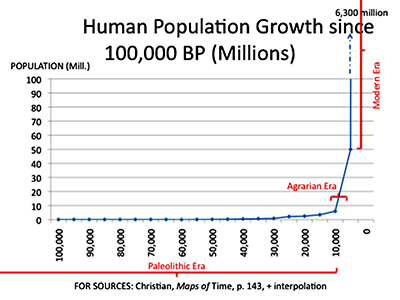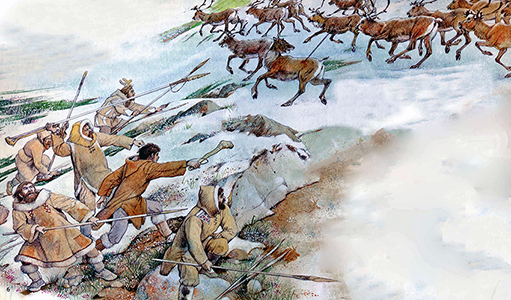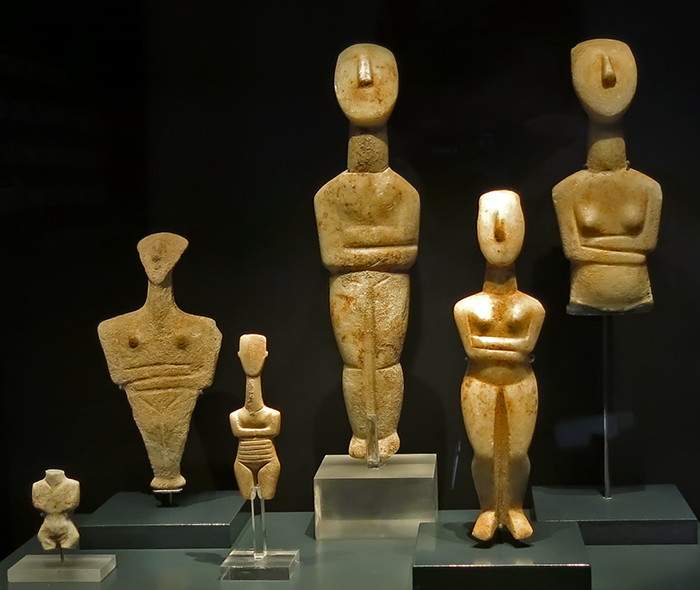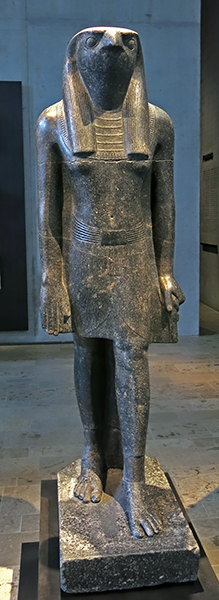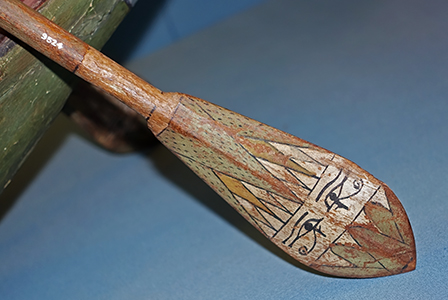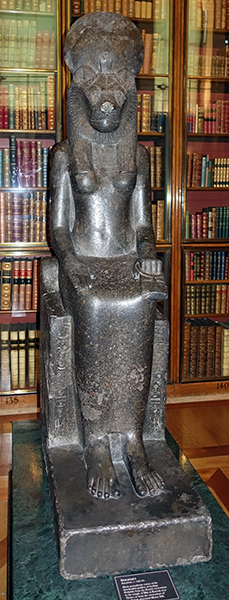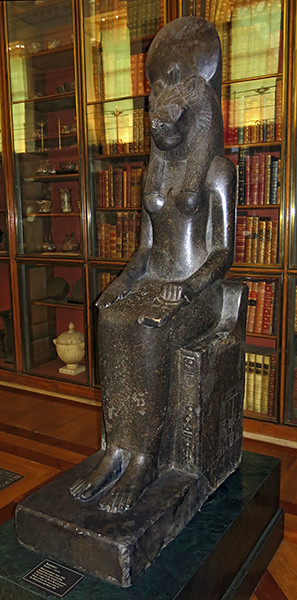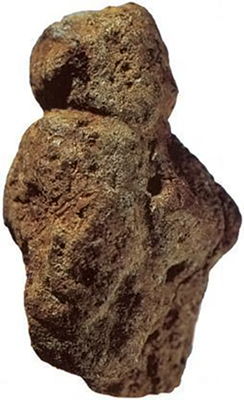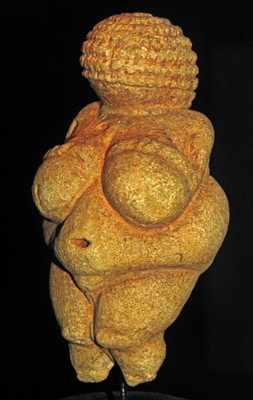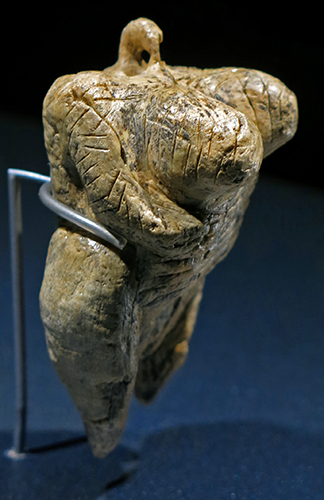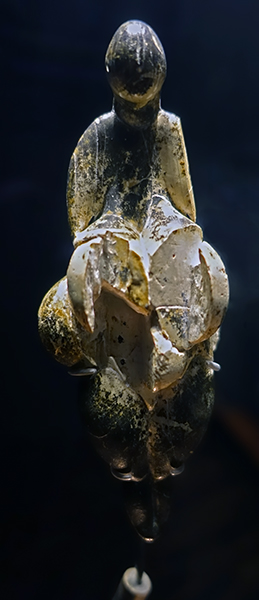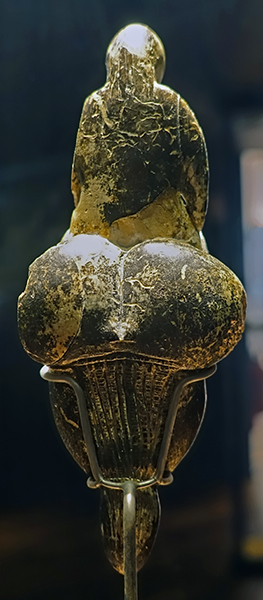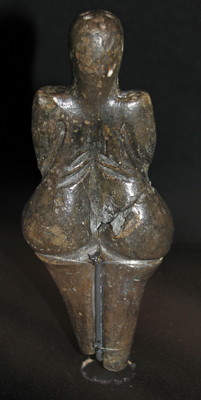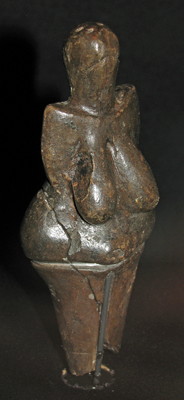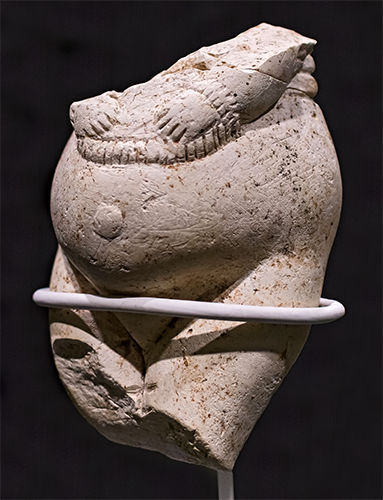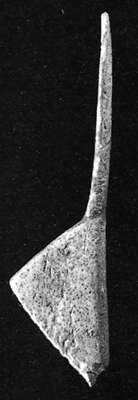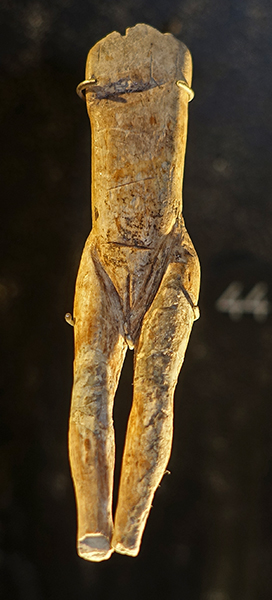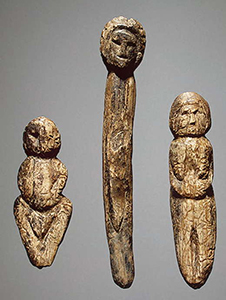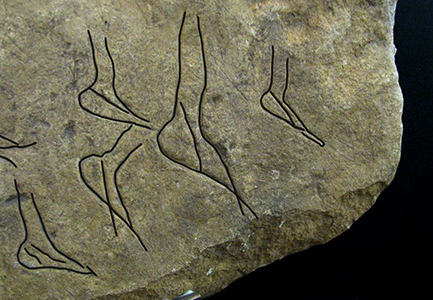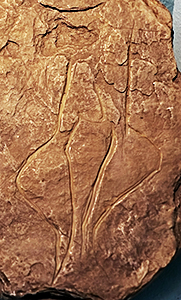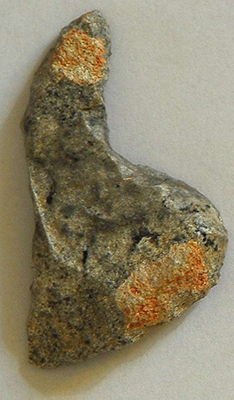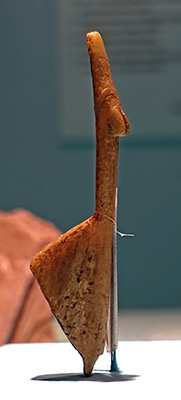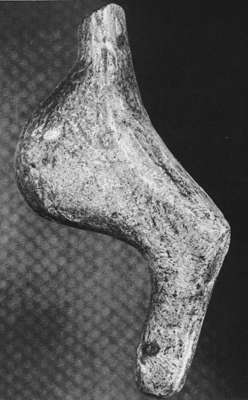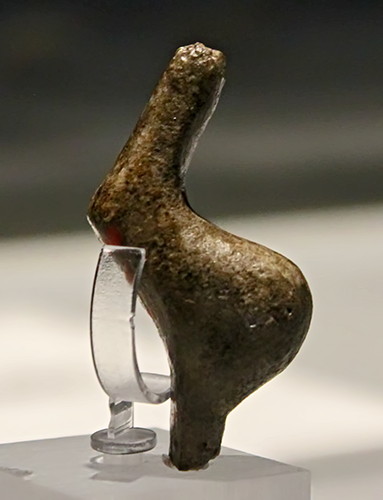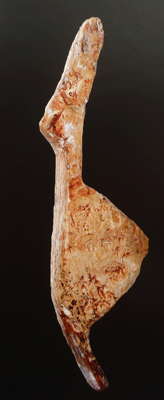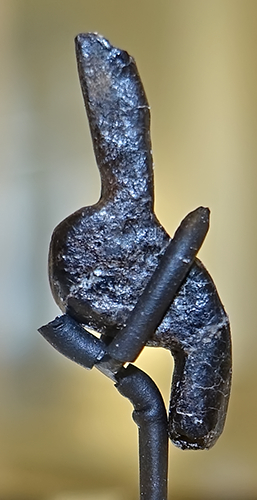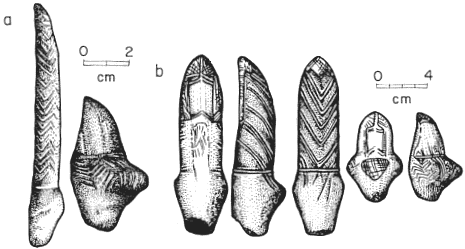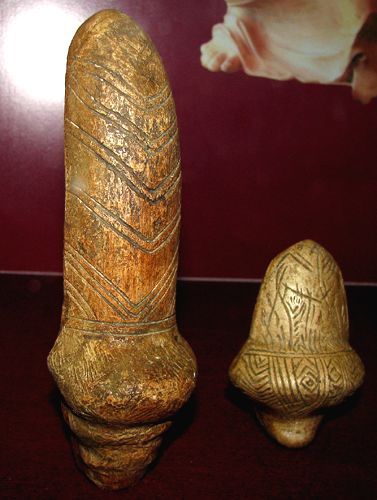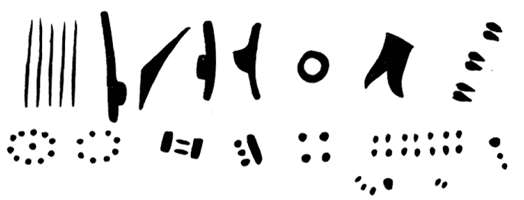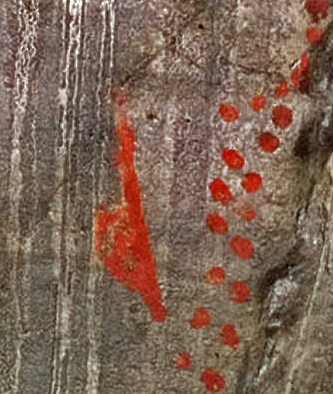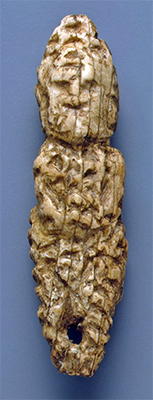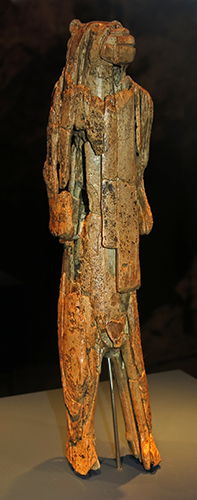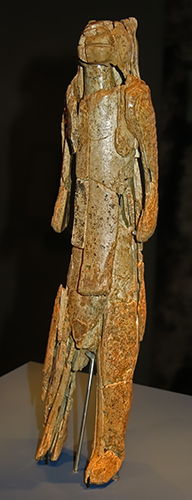Back to Don's Maps
What was the purpose of the Palaeolithic Venus figures?
There can be no single reason or purpose for the creation of venus figures, since the figures came from such disparate groups, across many thousands of years, and in any case with mutually incomprehensible languages.First and foremost, however, they are not meant to enhance fertility.
We can see the result of unrestricted fertility in any number of predator/prey studies of animals, as below:
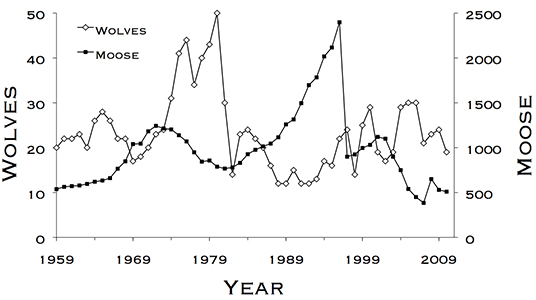
The wolves and moose of Isle Royale have been studied for more than five decades. This research represents the longest continuous study of any predator-prey system in the world.
When the respective populations of predators and prey is not controlled, we get a boom-bust cycle, as shown here for the populations of wolves and moose.
The effect is complicated by random effects of weather, parasites and disease.
Source: Vucetich & Peterson (2012)
If the humans of the Palaeolithic had not taken an active part in regulating their numbers, we would see a similar cycle for human populations.
Instead, the populations of Palaeolithic humans remained at a steady state for tens of thousands of years. This was not an accident.
One thing that we can see immediately from this graph is that the population of humans in Europe during the Palaeolithic was at a constant level, and quite low.
There was a small uptick in population when anatomically modern humans were able to colonise western and eastern Europe, and displace and replace the resident Neanderthals, but it was only when farming began that the population really began to climb.
For the duration of the Palaeolithic, human populations remained low, especially outside the equatorial region. The entire population of Europe between 16 000 BP and 11 000 BP likely averaged some 30 000 individuals, and between 40 000 BP and 16 000 BP, it was even lower at 4 000 – 6 000 individuals.
Source: https://worldhistoryconnected.press.uillinois.edu/6.3/christian.html
This indicates that the population was kept artificially low by use of population limiting cultural practices. This could arise using a number of means, all available to the people of those times:
• Prolonged nursing of newborns
with the resulting lack of fertility for at the very least six months, perhaps a lot longer.
• Sexual abstention
This is easier than it sounds - all that is necessary is for fertile women to be denied a husband, and vice versa, for a significant period of their reproductive lives. Historically that was achieved by women not being allowed to marry until they had reached a certain age, and/or until a suitable partner was found, thus truncating their possible reproductive life. There are various mechanisms to achieve this goal, and the systems can be very complex.
• Food taboos
to reduce protein, carbohydrates and fat intake for women who were likely to become pregnant, rendering them infertile. In modern times, elite female athletes may experience a loss of menstruation and thus fertility because of low fat levels, low body weight, and the effects of exercise related hormones.
• Infanticide
This could take the form of abandonment/exposure, suffocation, or ritual sacrifice, all methods which have been used in the times before agriculture. Neglect and intentional malnourishment may also have occurred. Even after agriculture was adopted, exposure of newborns was widely practiced in ancient Greece. It may have been that female children were more likely to be the objects of infanticide, further lowering the birth rate. As with present hunter/gatherer societies, they knew perfectly well how many people they could feed, and in times of shortage would have abandoned or killed unwanted children.
With regard to population control, Hayden (1972) writes that the threat of famine was close to non-existent in hunter gatherers. In fact, they had a routine and reliable food base, even in the worst conditions, and those in better environments enjoyed an even more substantial food supply. They eat whatever is available, whether it be of animal or vegetable or marine origin, but they usually had a great abundance of food. Hayden (1972) write that starvation in tropical and temperate regions was only amongst individuals incapacitated for other reasons. The only well documented cases of privation and starvation come from the arctic, sub-arctic, and extreme desert.
Thus, if hunter gatherers had acted in a normal predator/prey arrangement, they would have increased in numbers until each had enough to live on, perhaps, but there would often have been lean days, and a bad year would cause many to starve. By not increasing their numbers, and maintaining a high ratio of food to numbers, they had a good life. This is only possible if there are effective controls on population.
Malthus proposed that populations should increase to the maximum number that the environment would support, resulting in a minimum of resources per person. Amongst most modern hunter/gatherers there is a superabundance of resources per capita. In fact most groups work only 2 to 5 hours per person per day, and density has been estimated at 20% to 50% of carrying capacity, see DeVore & Lee (2013) and Woodburn (1988)
Wyman (2009) in a brilliant set of lectures on hunter gatherers, makes the following points: If you look where hunter-gatherers live now, each small group of about 40 people are spread out over a very large area and they use that area to hunt in and to collect fruits and nuts, and whatever they can get from the trees. It looks like a very simple question, why is the density of hunter-gatherers so low? Why are there so few of them?
For a long time, the answer was: they didn’t have much food. That they needed all this space to get enough food to survive, and if they overpopulated that space they couldn’t survive. In sort of modern hubris, we looked back and thought hunter-gatherer is a very inefficient form of food gathering, not modern, and we’re so much better than them now.
( Professor Wyman goes on to say that hunter-gathering is a very efficient way of gaining a comfortable life, eating very well from a very wide range of nutritious foods, both animal and vegetable, and working only a few hours each day - but you do need large areas of land to make the lifestyle work, and this means only about two million people on earth - Don )
The data is quite clear on some part of those assumptions; hunter-gatherers, at the time when all human beings were in the stage of hunter-gatherers, before farming started about 10 000 years ago. At that time here may have been like two million people on the whole earth. Hunter-gatherers spread out of Africa, spread amazingly over the whole earth, and maybe the total population of humans at that time was something like two million people. Now we have over six billion people, that’s an increase of 3 000 times in the human population, so clearly there were fewer hunter-gatherers than people now.
This is a very elementary kind of consideration. It talks about the long scale of human demography, of human population growth, and we came out of being other species of primate, of hominids and we gradually grew up to some sort of a limit. There’s the idea that the various productive systems that we use, like the hunter gathering limit is some sort of a carrying capacity limit, and so the idea is that the human population increased until it reached a limit and then for a very long period of time it can’t get beyond that limit.
Then 10 000 years ago, maybe it’s 12 000, farming is invented and all of a sudden the whole system changes, there’s many more people and we jump up and then again reach a limit, and we’ll talk about that as some Malthusian limit in this particular period, later we’ll discuss that, and then around here the industrial revolution happens and all of a sudden the population increases again.
This is a logarithmic scale so it’s not linear. Each of these jumps is by a factor of several thousand. That’s a very, very schematized version of human demographic history and we’re talking about this period. What limited hunter-gatherers to this level whereas farmers could go up to this level. Again, the obvious answer and looking at this kind of rough data is that it was food.
Whoever then–archeologists, paleontologists go and actually try to examine this and there turns out to be the data does not fit that theory terribly well. What do archeologists do? They dig up skeletons and they have a good representative set of skeletons from the last 7,000 years in North and South America. One study looked at more than 12,500 skeletons so we’re talking about a good scientific sample. What did they find out? These were set into communities, and communities lasted so much time, so you can date the whole archeological site to a certain period.&
The medical anthropologists got into it and started looking at the bones and dentition and all this, and not only did they find the violence we talked about last time, but these people were also sick. They had diseases at different times. You could see bone problems and how well the bones grew and from the teeth how much calcium they had, and all this. What does it turn out, that contrary to the idea of progress that you’d think the later people were more healthy, in fact, it was earlier people in the–the earlier individuals that were healthier. As time goes on, the skeletons get less and less healthy, that they’re getting less food and less good food, and were more subject to diseases.
It was quite a shocker when this status started coming out. The researchers attributed this decline in health in large part to the rise in agriculture. Two main factors they say, the rise of agriculture and the rise of urban living, and we’ll talk about the urban story in a moment. If you again go like we did last time from the archeology to the anthropology and look at current hunter-gatherers, it’s a little bit of a distorted study because nowadays almost all hunter-gatherers have been pushed out of the good lands that they used to live in, into very marginal lands.
You know this from U.S. History in high school, how the European farmers pushed the very earlier farmers or hunter-gatherers of the American Indians, the Native Americans into Arizona, into desert, into the Badlands in the West, the dry Badlands and to the West of the U.S., farming peoples push hunter-gatherers into inhospitable land.
There’s a story in the Smithsonian Magazine recently about Pygmies in Africa. I don’t know if you know a little bit about the history of African demography, which we’ll also cover, but the Bantus have expanded from south–the bulge of southwest Africa basically all around and have pushed other people’s out and the Pygmies are one of the groups that have been very severely discriminated against and really pushed into inhospitable places.
Another example is the Bushmen of Africa who were pushed into the Kalahari Desert in southern Africa. Even in the desert these guys eat 85 different species of plants, and it’s almost inconceivable in their culture, for someone to die of starvation because plants will bloom some years and not bloom some years. They will get a fungus some year, or a virus, plants–any one species is not generally very reliable. When you have 85 different species to survive on you’re not going to go without food. There will always be some group of plants that are going to be available to you and so you’re not going to starve.
Further, the anthropologists lived with these people and they start writing down what they’re doing at every point in time. Per hour invested, the Bushmen get more food then the early agriculturalists. Not modern agriculturalists who can drive a tractor and in an hour do a lot, but we’re comparing hunter-gatherers to the first stages of agriculture. The Kalahari–the Bushmen in Kalahari spent 12 to 19 hours a week collecting food and the rest of the time they used for a lot more sleep than current farmers, and a lot more leisure than farming people, so life is more generous to them.
You have to think now, this is for people pushed into a desert, a very inhospitable place, and now if they–if you can imagine them living in a lush forest region where they originated, life must have been much, much easier so the amount of time exerted to get your basics of food and everything must have been much–a lot less. Not only do they have to work less and they get more food per hour, but the variety of foods is very good for you because you need different minerals, you need different other micronutrients, you need different vitamins, and as we are bombarded with in the popular press, a variety of foods is very good for you. You don’t want to eat just one kind of food, so they had a very diverse and healthy kind of diet.
Thus I do not believe that Venus figures were used to enhance fertility.
The idea was to reduce fertility to replacement levels only, so that the land available could support the existing population at its optimum level, but factoring in the surety of excess supply in case of poor seasons.
The hunter gatherers of the Palaeolithic ranged far and wide, often travelling large distances during the year in order to harvest resources which were time and place dependent, such as the migration of reindeer and ibex between summer and winter pastures, or the movements of fish up the rivers, or the migrations of horses, bison and aurochs.
Thus each band or group of bands had their own territories. Humans are territorial, like birds or lions or ants, and all other animals.
A wonderful book on this topic is by Robert Ardrey, The Territorial Imperative, Ardrey (1966)
When hunting reindeer, the band cooperated closely. Their long, thin and flexible darts were launched from a spear thrower or atlatl, which was a lever which allowed the hunters to get a much greater range and force for their shafts. The darts were armed with both flint blades and with barbed antler harpoons.
We think of harpoons (that is, barbed bone or antler spear points) as being used for fish and large sea animals such as seals and whales, but they were first developed for reindeer hunting, and only later adapted for use with fish and marine mammals.
Photo and text: Adapted from Caselli (1985)
Additional text: Bibby (1956)
Which leaves us with the question - Why?
Often a great deal of time and effort was expended in making the Venus Figures, and they were often works of considerable artistic merit. Most must have had some very important purpose.
The obvious purpose is that of the representation of gods and goddesses. The Löwenmensch is obviously a male deity, and most female venus figures are probably of female deities.
I believe that most served some useful ritual or spiritual purpose - perhaps to protect the group from injury or disease, or to ensure successful hunts, or simply as a tribute to the deities that controlled the herds and the weather, and perhaps the rising of the sun, and the passage of the seasons.
If so, this would imply the existence of, at the very least, spirits or deities which could influence events.
Some of the Venus figures may well have been cult figures, and the subject of idolatry, the worship of an idol or cult image. They may have been asked for favours of all kinds.
This is especially possible where a large amount of time, effort, and skill has been expended in the carving or making of the figure. Candidates for this role include the Löwenmensch, the Venus of Willendorf, the Venus of Lespugue, the Venus of Dolni Vestonice, and the large limestone venus from Kostenki.
In the latter case, the limestone venus from Kostenki has been broken, which may be accidental or for good perceived reason.
We can now have no knowledge of exactly how these sculptures, paintings, and engravings were used, but there are historical parallels, as below.
Cycladic Idols, circa 3 000 BC, developed from an interplay of naturalistic and abstract forms, and, like the Gönnersdorf culture sculptures, were made in large numbers.
They reference stone age idols, but reduce their bulky physicality and use a number of stylised protocols. The canonical figure shows a standing naked woman with arms crossed under her breasts. These idols are subdivided into subtypes that co-existed during the golden age of Cycladic culture, due to certain design features.
Classic Cycladic Idols
Photo: Don Hitchcock 2015
On loan from Badisches Landesmuseum Karlsruhe
Source and text: Archäologische Staatssammlung München
Ancient Egypt provides us with many examples of statues of gods, often placed within temples, and prayed to by the priests of the temple dedicated to that god, and, on occasion, by the Pharaoh. One such is the Egyptian Falcon-headed god, Horus, as shown below:
Eighteenth Dynasty: 1 550 BC - 1 292 BC
Horus
Standing-striding statue of the god Horus.
New Kingdom, circa 1 360 BC
Catalog: Granodiorite, Theben-West, Mortuary Temple of Amenhotep III / Amenophis III (?), Gl.WAF 22a
Photo: Don Hitchcock 2015
Source: Original, Ägyptischen Museum München
Text: © Ägyptischen Museum München
From Ancient Egypt we have parallels to the painted or quickly engraved images of the female symbol from the Gönnersdorf/Lalinde culture, in the Wedjat, or 'Eye of Horus':
Twelfth Dynasty: 1 991 BC - 1 802 BC
Funerary Boat Oar
Close up of a painted wooden model of a funerary boat oar, circa 1 850 BC.
( note the Wedjat eyes on the oar to provide protection from harm - Don )
The Eye of Horus, also known as wadjet, wedjat or udjat, is an ancient Egyptian symbol of protection, royal power, and good health. Ancient Egyptian and Middle-Eastern sailors would frequently paint the symbol on the bows of their vessels to ensure safe sea travel.
Catalog: Thebes, EA9524
Photo: Don Hitchcock 2018
Source: Original, British Museum
Text: Card with the display at the British Museum, © Trustees of the British Museum, CC BY-NC-SA 4.0
Additional text: Wikipedia
From Ancient Egypt, we also have, like the chimeric male Löwenmensch from the Palaeolithic, a sculpture of Sekhmet, a lion-headed female goddess:
Eighteenth Dynasty: 1 550 BC - 1 292 BC
Sekhmet
Black granodiorite statue of the lion-headed goddess of healing, circa 1 370 BC.
Photo: Don Hitchcock 2015, 2018
Source: Original, British Museum
Text: © Card with the display at the British Museum, © Trustees of the British Museum, CC BY-NC-SA 4.0, http://www.britishmuseum.org/
Overview of various types of Venus Figures
The Oldest Venus Figure
The female figurine from Berekhat Ram, in Israel. It is the oldest known figurative carving in the world, and is somewhere between 233 000 and 800 000 years old, older than Neanderthal man, and probably carved by Homo Erectus. The date is between these values because it has been found between two layers of volcanic rocks, the upper one about 230 000 years old, and the lower one approximating 800 000 years old. The figurine itself is estimated to be approximately 250 000 - 280 000 years old, based on the stratigraphy.
Its dimensions are 35 mm high, 25 mm wide, and 21 mm thick, and it weighs 10.33 g.
The original pebble bore a resemblance to a female, and this was enhanced by the carver, who cut grooves around the neck and along its arms. Microscopic analysis by Alexander Marshack has now made it clear that humans were responsible. It is carved into a piece of tuff, which is formed when volcanic ash settles on the landscape and is hot enough to weld together into a light, porous rock, often like pumice stone, which is tuff formed on the surface of the ocean.
Photo: Bahn (1998)
Text: Various sources
Obese Venus Figures
These are the iconic type of Venus figure that most people think of when the topic of Venus figures comes up
Many, though by no means all of the venus figures are obese, such as the Venus of Willendorf and the Venus of Hohle Fels.
Obesity may have been a desirable trait because of the fat reserves to tide the bearer over times of famine. But why carve these figures at all, whether overweight, of normal fat distribution, or downright skinny?
I spent some time in the Vienna Natural History Museum one day in September 2008. This image of the original Venus of Willendorf is from that session.
This venus, and the Löwenmensch, or Lion Man, share equal top billing for the most important venus figures.
Opinion is divided about the pattern around the head.
Some say it is braided hair, others say it is a woven (or crocheted!)
hat pulled low over the face. There is evidence for woven textiles
from that time. It could also be basketry.
But all agree that it is deliberate, to hide the face. The question is, why?
All sorts of theories have been put forward - that it is an anonymous
female, or that it is the earth mother, whose face not only cannot
be seen, but must not be seen.
All conjecture, and your guess is as good as anyone else's.
The thick circles at the top of the breasts of the Willendorf venus
are vestigial arms. If you look at the figure closely, you can see the
matchstick arms starting at the shoulders, and continuing down the
body and across the breasts. Look closer still, and you can see
bangles or arm ornaments at the wrists. Even hands with fingers are
indicated.
Photo: Don Hitchcock, 2008
Source: Original in the Vienna Natural History Museum
The Venus of Hohle Fels, height 59.7 mm
This is a most unusual venus. It carries the apparent wish not to show the face of the earth mother figure to its logical extreme, and the head and face have been replaced altogether with just a small loop of ivory for a cord.
In addition, in marked contrast to other venus figures, it has not been polished or at least smoothed. Instead it has deep markings on the breasts, arms and abdomen that look like cicatrices, cuts in the skin that have been immediately rubbed with ash to make them stand out from the rest of the body. These are similar markings to the animal figures from the nearby cave of Vogelherd.
The breasts of the figure have been greatly exaggerated, and jut out from the body in an unnatural manner. The shoulders are broad and strong. The abdomen is in keeping with the thick thighs, yet the buttocks are almost non-existent. There are no hands or feet shown.
Photo: Don Hitchcock 2015
Source: Original, Urgeschichtliches Museum Blaubeuren
The Lespugue Venus, Front and back view.
Photo:Don Hitchcock 2018
Source: Original, Paris, Musée de l'Homme
Venus of Dolní Věstonice
Moravia, Czech Republic
Ceramic
31 000 – 30 000 cal. BP (dating from Professor Jiří Svoboda)
Loan: Anthroposmuseum in Brno
Photo: Don Hitchcock 2008
Source: Original, Vienna Natural History Museum
The Kostenki limestone venus.
Height: 137 mm
Gravettian, circa 25 000 BP, original,
Kostenki is a very important Palaeolithic site on the Don River in Russia. It was a settlement which contained venus figures, dwellings made of mammoth bones, and many flint tools and bone implements. Kostenki / Kostienki is not actually a single site but really an area on the right bank of the Don River in the regions of the villages of Kostenki and Borshevo, consisting of more than twenty site locations, all dating to the Palaeolithic.
Photo: Thilo Parg
Permission: CC BY-SA 4.0
Source: original, exhibited at the Archeological Museum Hamburg (Ice Age - The Art of the Mammoth Hunters from 18 October 2016 to 14 May 2017)
On loan from the Hermitage Museum, Saint Petersburg, Russia.
Abstract, naturalistic, and thin Venus Figures
A symbolic, abstract Venus Figure from Gönnersdorf.
Ivory statuette with rod-shaped upper body.
Height 54 mm, width 14 mm.
Modern researchers have mostly concentrated on the voluptuous or obese female venus figures, for whatever reasons, and have ignored the vast majority, which are of normal proportions, or are obviously symbolic only, although with sometimes exaggerated female characteristics, which in the case of the Lalinde/Gönnersdorf figures (see photo above and the more detailed examination below), means only the buttocks, and not the breasts, which are barely shown or nonexistent.
Photo: Müller-Beck et al. (1987)
In marked contrast to the obese venus figures, is the first venus figure found in France, the Venus Impudique, which is of a young girl, barely pubescent. This venus is closer to a portrait than a sculpture with deep meaning.
Photo: Don Hitchcock 2018
Source: Paris, Musée de l'Homme
Some, in particular from some Siberian sites such as Mal'ta - Buret', look to me more like children's dolls than what might normally be called venus or mother goddess figures.
The Lalinde/Gönnersdorf enigma
At first blush it would be thought to be axiomatic that there could be little cultural exchange between palaeolithic sites a thousand or more kilometres apart.
The Lalinde/Gönnersdorf cultural artefacts blow this theory out of the water. We can talk of obviously identical cultural norms more than 3000 km apart. In Palaeolithic times this is hard to believe, but the evidence is there.
(left) La Roche de Lalinde engravings.
(right) engravings from Gönnersdorf, more than 1000 km to the east of Lalinde.
Note the almost identical shape and form in these engravings, more than 1000 km apart. It is unclear how this transfer of a style and the associated cultural definitions could possibly have happened.
(left) Chipped stone female figurine in the Lalinde/Gönnersdorf style from Wilczyce, Poland
(right) Venus figurine in bone from Gönnersdorf.
The Gönnersdorf venus shown here is important not just because it is superbly made, but because it defines the orientation of the Lalinde/Gönnersdorf venus figures.
This is not always easy to determine, and some sculptures of this genre have been displayed 'upside down', as was formerly the case with the Venus of Pekarna, from Moravia, not far from Brno in the Czech Republic, as shown below:
The Venus of Pekarna (Moravia). Pekárna Cave is about 900 km east of Gönnersdorf, and 300 km south of Wilczyce in Poland.
At one time the venus was displayed in a different orientation, as at left.
Photo: (left) Müller-Beck and Albrecht (1987)
Photo: (right) Ralph Frenken
Source: Facsimile, exhibited at the Archeological Museum Hamburg (Ice Age - The Art of the Mammoth Hunters from 18 October 2016 to 14 May 2017). On loan from the Hermitage Museum, Saint Petersburg, Russia.
Ölknitz Venus in ivory.
Ölknitz, or Oelknitz, is about 400 km east of Gönnersdorf. A number of Gönnersdorf culture venus figures have been found there.
Photo: Rau et al. (2009)
Some are not much more than abstract female figures, completed in a short time as engravings or painted outlines, as in the Lalinde/Gönnersdorf engravings, while others, similarly abstract, and with the same general design, would have taken a lot of time and effort to make.
This is especially so for the Lalinde/Gönnersdorf figurines and art works. In this case we have one of the few cases where a similar art form was used over vast distances - even if we just take the artworks at Lalinde and Gönnersdorf, they are very similar in form and content, yet are separated by more than 1000 km. Wilczyce is a further 880 km to the east of Gönnersdorf.
Petersfels Venus figure.
Petersfels is a few kilometres from Engen, Baden-Wurttemberg, and more than 400 km from Gönnersdorf.
This site has no engravings, but a large number of Gönnersdorf style venus figures, made in jet, a form of hard coal.
Photo: Don Hitchcock 2018
Source: Original, Archäologisches Museum Colombischlössle, Freiburg, Germany
Drawings of thirteen of the Petersfels Venus figures, to scale.
Though this series is not complete, it is a valuable reference for many of the venus figures from Petersfels.
Artist: Not recorded
Rephotography: Don Hitchcock 2018
Source: Adapted from a display at the Engen Municipal Museum and Gallery
The variously designated bird/phallic/female figurines from Mizyn, in Ukraine, are also a part of the Lalinde/Gönnersdorf culture.
Mizyn is more than 3000 km from Lalinde, but the artworks are clearly part of the same tradition, though translated into a more 'chunky' style, and in mammoth ivory, like the venus figurines of Gönnersdorf (done as figurines in bone and antler, and ivory at the nearby Andernach), rather than in the form of just engravings, as at Lalinde.
Photo: Soffer (1986)
These Lalinde/Gönnersdorf culture sculptures, and others like them from Mizyn, have been variously described as phallic figurines, birds, and bird/woman hybrids. They were made originally in Mammoth ivory.
Photo: Don Hitchcock 2008
Source: Facsimiles in the Vienna Natural History Museum
Some of the red and black figures from the main gallery of Niaux.
Note in particular the four 'claviform' figures, which appear to be derived from the Lalinde/Gönnersdorf culture.
Photo: Breuil, Cartailhac (1907)
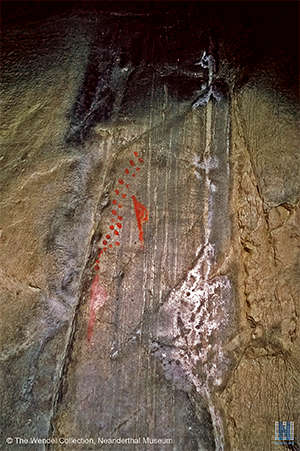
Salon Noir
Two claviform symbols from Niaux, and a double line of dots.
Photo: Heinrich Wendel (© The Wendel Collection, Neanderthal Museum)
This 'claviform figure' from Niaux (close up from the image above) is identical in shape to those of the the Lalinde/Gönnersdorf culture, an effect which may be better seen by rotation of the image, as at right.
Photo: Heinrich Wendel (© The Wendel Collection, Neanderthal Museum)
From inspection of the available evidence, it seems to me that the centre of the Lalinde/Gönnersdorf culture was the area surrounding the present day towns of Gönnersdorf and Andernach, which are less than 20 kilometres apart. It is at these sites that there were venus sculptures of many types, as well as a multitude of engravings in the Lalinde/Gönnersdorf style.
At Lalinde, the only examples are of engravings. At Niaux, the only examples are paintings, and these are often inverted.
We have a series of well made Venus figures in flint from Wilczyce, Poland. We have a series of well made sculptures in mammoth ivory from Mizyn.
Thus this Venus culture was exported essentially unchanged to Pekarna in the Czech Republic, to Wilczyce in Poland, and to Mizyn in Ukraine, from the Lalinde/Gönnersdorf area of present day Germany.
However only parts of the culture made their way to France, at Lalinde (engravings) and Niaux (paintings). Nevertheless this is an amazing concept to contemplate - that the culture could be spread over such a huge area during the Palaeolithic.
This would seem to indicate that this set of venus figures were hugely important to the people of the Lalinde/Gönnersdorf culture, and that the venus figures (expressed variously as sculptures, engravings and paintings) had great importance in their spiritual life.
None of the other venus figures spawned such a huge geographic distribution, more than 3300 kilometres apart from one end of the range to the other if we measure from Niaux to Mizyn.
Clothed, slim Venus Figures
Apart from what may be described as a 'loin cloth' or possibly a short skirt on the Lespugue Venus, all the clothed venus figures found so far come from the Mal'ta site in Siberia.
(left) Figurine, Mal'ta, Height 42 mm, Width 8 mm
(right) Figurine, Mal'ta. At first the head on this piece looks grotesquely wide and high, but I think it is just the effect of a face peeking out from a fur head dress. Height 44 mm.
Twenty heads are known, isolated or belonging to figurines, but two of them are mere sketches. For all the others, the hair, or hairstyle, is shown. It should be pointed out, however, that in several cases as shown here it is a hairstyle, such as a 'balaclava', for which the hairstyle is indistinguishable from that of clothing.
In any case, the hair or hairstyle is long, often narrowly framing the face and falling down the back. For two or three statuettes, this hairstyle is represented only in outline, but more generally, it is marked by incisions, which may be of several types: relatively straight and following the natural movement of long hair, wider and wavy, but mostly in the form of small crescents arranged in various ways or from small circular cupules.
Photo (left): http://www.nihilum.republika.pl/
Photo (right and centre): http://www.hermitagemuseum.org/
Text: Delporte (1979)
An in-depth study of the Mal'ta Venuses conducted by Dr Lyudmila Lbova (photo above) and Dr Pavel Volkov of the Russian Academy of Sciences has determined that the figurines are not idealised nude females, but depictions of clothed individuals - many of them depicting men, teenagers, and children.
Through microscopic examination and macro photography, Drs. Lbova and Volkoy were able to discover traces of lines that were not able to be seen by the naked eye due to ravages over time. These lines depicted more details of clothes that were not previously seen such as bracelets, hats, shoes, bags, and even back packs. The team also discovered that the creators of the figurines depicted different hats, hairstyles, and other accessories, and use different carving techniques to highlight the different materials such as fur and leather.
Although the function of these figurines are still unknown, it is clear from the study that the Venus/Mother Goddess connotations attached to these figurines will have to be completely reevaluated. According to Dr. Lbova: 'What we can say for sure is that these realistic details of clothes, accessories, hairstyle clearly show that ancient masters made the figurines of some real people, maybe their relatives. I strongly doubt that these were the images of abstract goddesses or spirits in the sense often used to understand so-called Venus depictions.'
Photo: © Vera Salnitskaya
Source: http://siberiantimes.com/
Text: adapted from http://fuckyeaharchaeology.tumblr.com/post/139873235297/siberian-venus-figurines-are-not-venuses-after
A lithe, naturalistic, well proportioned, and well muscled venus figure
The Lion Man of Ulm, Germany - the Löwenmensch. Aurignacian, in a level dated to between 40 000 BP - 35 000 BP.
This is one of the most important venus figures, and one of the oldest, along with the Venus of Hohle Fels, of similar age. Originally thought to be female, since it was patently a venus, it has since been found to be male.
In about 2013, Wulf Hein and Kurt Wehrberger recreated this sculpture, using only palaeolithic tools available at the time of the creation of the original.
The time required to create the original was possibly 400 hours, or seven weeks at eight hours a day with no days off. As all of this probably needed to be done in daylight rather than firelight to achieve the accuracy and detail in work that was often hard and monotonous, two months or more is perhaps a reasonable estimate of the time required.
This also suggests that, unless the sculpture was created slowly at odd moments over several months, someone as skilled as an artist may have been excused from other subsistence tasks to work specially on this piece. The experiment emphasises how valuable this sculpture must have been and, although little is known about its meaning or significance, it is clear that it was produced by a mind that could imagine and manufacture an artwork of symbolic importance.
Photo: Don Hitchcock 2015
Source: Original, Ulmer Museum, Germany
Text: adapted from Cook (2013)
The fact that the Löwenmensch, the Lion Man, is a chimera, a 'hybrid' creature composed of the parts of more than one animal, in this case a lion and a human, is very significant. It is a strong indication that this venus figure is, indeed, meant to be a god or spirit figure.
References
- Ardrey, R., 1966: The Territorial Imperative: A Personal Inquiry into the Animal Origins of Property and Nations, New York: Atheneum.
- Bahn P., 1998: The Cambridge illustrated history of prehistoric art, Cambridge University Press
- Bibby, G., 1956: The Testimony of the Spade, Alfred A. Knopf, 424 pp.
- Breuil, H., Cartailhac É., 1907: Une seconde campagne aux cavernes ornées de Niaux (Ariège) et de Gargas (Hautes-Pyrénées). Comptes-rendus des séances de l'année.. - Académie des inscriptions et belles-lettres, 51e année, N.4, 1907. pp. 213-222.
- Caselli, G., 1985: The Everyday Life of an Ice Age Hunter, Macdonald & Co.
- Cook, J., 2013: Ice Age art: arrival of the modern mind, The British Museum, 18 Feb 2013, ISBN-10: 0714123331, ISBN-13: 978-0714123332
- Hayden, B., 1972: Population Control among Hunter/Gatherers, World Archaeology, 4, no. 2 (1972): 205–21. http://www.jstor.org/stable/123977. 0714123331, ISBN-13: 978-0714123332
- DeVore, I., Lee R., 2013:Kalahari Hunter-Gatherers: Studies of the !Kung San and Their Neighbors, Harvard University Press - 2013
- Müller-Beck, H. and Albrecht, G. (Ed.), 1987: Die Anfänge der Kunst vor 30000 Jahren, Theiss: Stuttgart.
- Rau, S., Naumann D., Barth M., Mühleis Y., Bleckmann C., 2009: Eiszeit: Kunst und Kultur, Thorbecke, 2009, 396p. ISBN: 978-3-7995-0833-9
- Rice, P., 2009: Journal of Anthropological Research Vol. 37, No. 4 (Winter, 1981), pp. 402-414 (13 pages)
- Soffer, O., 1986: The upper palaeolithic of the central Russian plain, New York, Academic Press, 1986
- Vucetich, J., Peterson R., 2012: The population biology of Isle Royale wolves and moose: an overview., https://isleroyalewolf.org/data/data/home.html
- Woodburn, J., 1988: Hunters and gatherers - History evolution, 2nd Ed., 1st January 1988, ISBN: 9780854967346
- Wyman, R., 2009: Global Problems of Population Growth MCDB 150 - Lecture 4 - When Humans Were Scarce, https://oyc.yale.edu/courses
Sources
- Graph of human population in the Palaeolithic: https://worldhistoryconnected.press.uillinois.edu/6.3/christian.html
- Ice age Hunters: https://www.donsmaps.com/iceagehunters.html
- Lespugue Venus: https://www.donsmaps.com/lespuguevenus.html
- The Löwenmensch, the Lion Man from Hohlenstein-Stadel: https://www.donsmaps.com/lionlady.html
- Venus figure from Pekarna (Moravia, Czech Republic): https://www.donsmaps.com/venuspekarna.html
- Venus figures from Gönnersdorf/Andernach: https://www.donsmaps.com/gonnersdorf.html
- Venus figures from Lalinde/Gönnersdorf: https://www.donsmaps.com/couze.html
- Venus figures from Mal'ta - Buret': https://www.donsmaps.com/malta.html
- Venus figures from Petersfels: https://www.donsmaps.com/petersfels.html
- Venus of Berekhat Ram: https://www.donsmaps.com/berekhatram.html
- Venus of Hohle Fels: https://www.donsmaps.com/hohlefelsvenus.html
- Venus of Willendorf: https://www.donsmaps.com/willendorf.html
